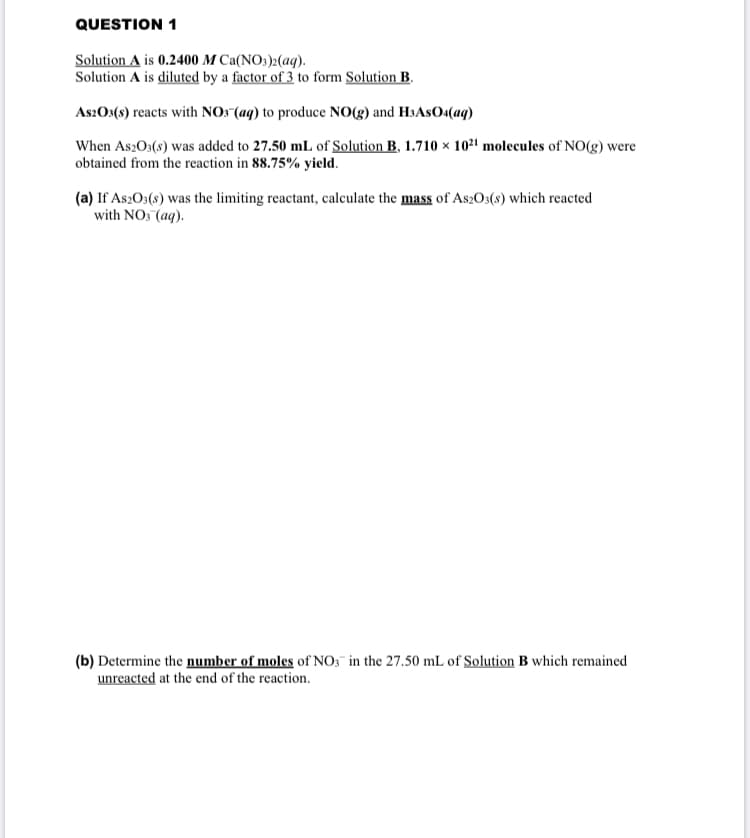Solution A is 0.2400 M Ca(NO)2(aq). Solution A is diluted by a factor of 3 to form Solution B. AszOs(s) reacts with NO3"(aq) to produce NO(g) and HJASO4(aq) When As2O3(8) was added to 27.50 mL of Solution B, 1.710 x 1021 molecules of NO(g) were obtained from the reaction in 88.75% yield. (a) If As2O3(s) was the limiting reactant, calculate the mass of As2Os(8) which reacted with NOS (aq). (b) Determine the number of moles of NO, in the 27.50 mL of Solution B which remained unreacted at the end of the reaction.
Solution A is 0.2400 M Ca(NO)2(aq). Solution A is diluted by a factor of 3 to form Solution B. AszOs(s) reacts with NO3"(aq) to produce NO(g) and HJASO4(aq) When As2O3(8) was added to 27.50 mL of Solution B, 1.710 x 1021 molecules of NO(g) were obtained from the reaction in 88.75% yield. (a) If As2O3(s) was the limiting reactant, calculate the mass of As2Os(8) which reacted with NOS (aq). (b) Determine the number of moles of NO, in the 27.50 mL of Solution B which remained unreacted at the end of the reaction.
Chemistry: Principles and Reactions
8th Edition
ISBN:9781305079373
Author:William L. Masterton, Cecile N. Hurley
Publisher:William L. Masterton, Cecile N. Hurley
Chapter10: Solutions
Section: Chapter Questions
Problem 16QAP
Related questions
Question
Solution A is 0.2400 M Ca(NO3)2(aq).
Solution A is diluted by a factor of 3 to form Solution B.
As2O3(s) reacts with NO3–(aq) to produce NO(g) and H3AsO4(aq)
When As2O3(s) was added to 27.50 mL of Solution B, 1.710 × 1021 molecules of NO(g) were
obtained from the reaction in 88.75% yield.
(a) If As2O3(s) was the limiting reactant, calculate the mass of As2O3(s) which reacted
with NO3–(aq).
(b) Determine the number of moles of NO3– in the 27.50 mL of Solution B which remained unreacted at the end of the reaction

Transcribed Image Text:Solution A is 0.2400 M Ca(NO)2(aq).
Solution A is diluted by a factor of 3 to form Solution B.
AszOs(s) reacts with NO3"(aq) to produce NO(g) and HJASO4(aq)
When As2O3(8) was added to 27.50 mL of Solution B, 1.710 x 1021 molecules of NO(g) were
obtained from the reaction in 88.75% yield.
(a) If As2O3(s) was the limiting reactant, calculate the mass of As2Os(8) which reacted
with NOS (aq).
(b) Determine the number of moles of NO, in the 27.50 mL of Solution B which remained
unreacted at the end of the reaction.
Expert Solution
This question has been solved!
Explore an expertly crafted, step-by-step solution for a thorough understanding of key concepts.
This is a popular solution!
Trending now
This is a popular solution!
Step by step
Solved in 4 steps

Knowledge Booster
Learn more about
Need a deep-dive on the concept behind this application? Look no further. Learn more about this topic, chemistry and related others by exploring similar questions and additional content below.Recommended textbooks for you

Chemistry: Principles and Reactions
Chemistry
ISBN:
9781305079373
Author:
William L. Masterton, Cecile N. Hurley
Publisher:
Cengage Learning

Chemistry & Chemical Reactivity
Chemistry
ISBN:
9781133949640
Author:
John C. Kotz, Paul M. Treichel, John Townsend, David Treichel
Publisher:
Cengage Learning

Introductory Chemistry: A Foundation
Chemistry
ISBN:
9781337399425
Author:
Steven S. Zumdahl, Donald J. DeCoste
Publisher:
Cengage Learning

Chemistry: Principles and Reactions
Chemistry
ISBN:
9781305079373
Author:
William L. Masterton, Cecile N. Hurley
Publisher:
Cengage Learning

Chemistry & Chemical Reactivity
Chemistry
ISBN:
9781133949640
Author:
John C. Kotz, Paul M. Treichel, John Townsend, David Treichel
Publisher:
Cengage Learning

Introductory Chemistry: A Foundation
Chemistry
ISBN:
9781337399425
Author:
Steven S. Zumdahl, Donald J. DeCoste
Publisher:
Cengage Learning

Chemistry for Engineering Students
Chemistry
ISBN:
9781337398909
Author:
Lawrence S. Brown, Tom Holme
Publisher:
Cengage Learning

General Chemistry - Standalone book (MindTap Cour…
Chemistry
ISBN:
9781305580343
Author:
Steven D. Gammon, Ebbing, Darrell Ebbing, Steven D., Darrell; Gammon, Darrell Ebbing; Steven D. Gammon, Darrell D.; Gammon, Ebbing; Steven D. Gammon; Darrell
Publisher:
Cengage Learning

Chemistry: An Atoms First Approach
Chemistry
ISBN:
9781305079243
Author:
Steven S. Zumdahl, Susan A. Zumdahl
Publisher:
Cengage Learning